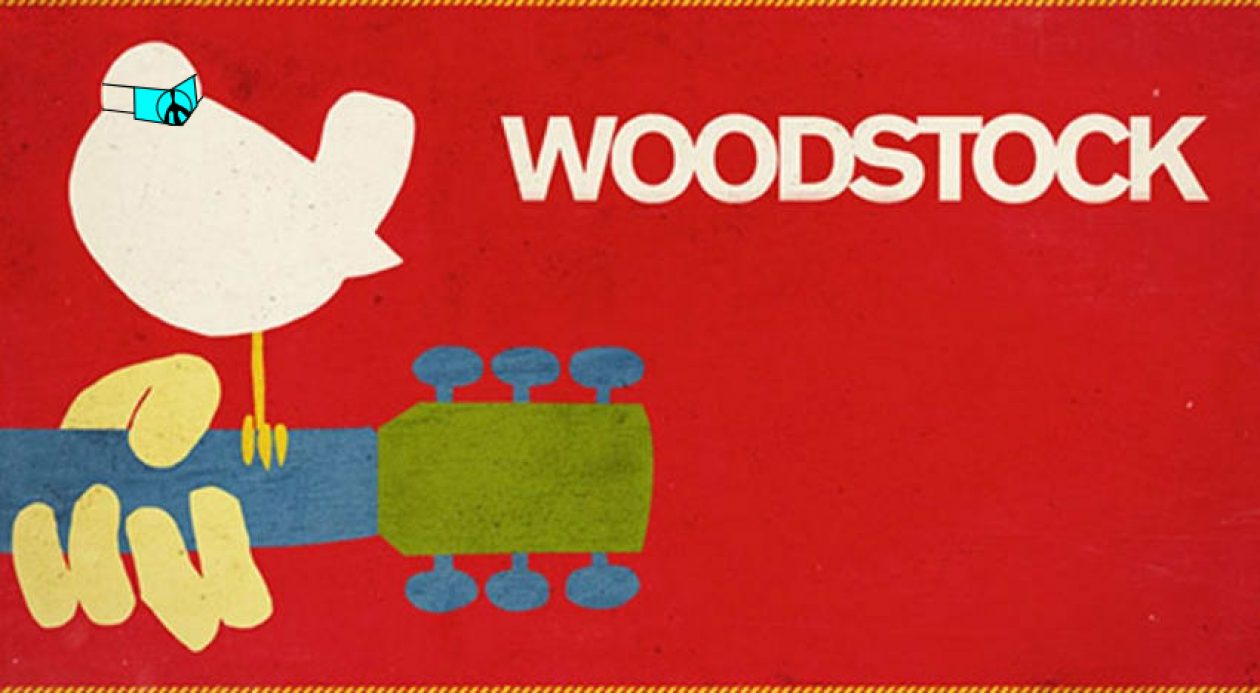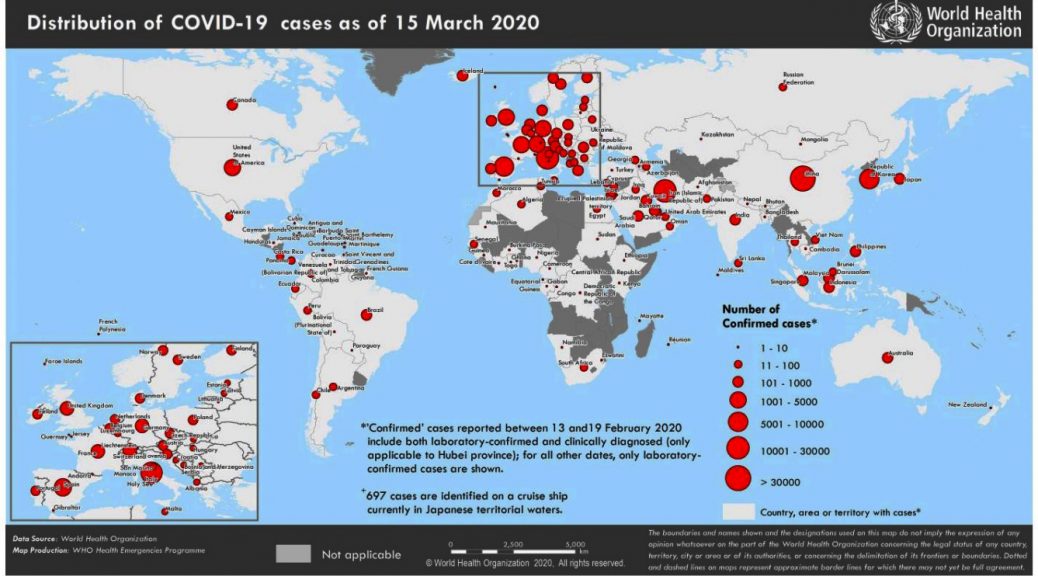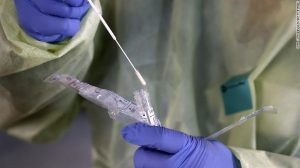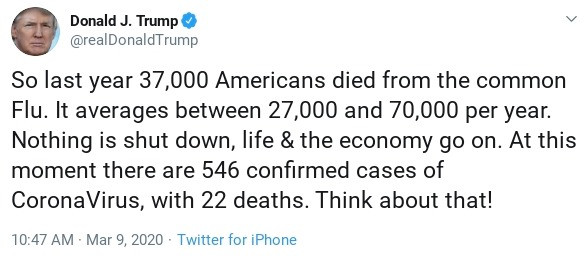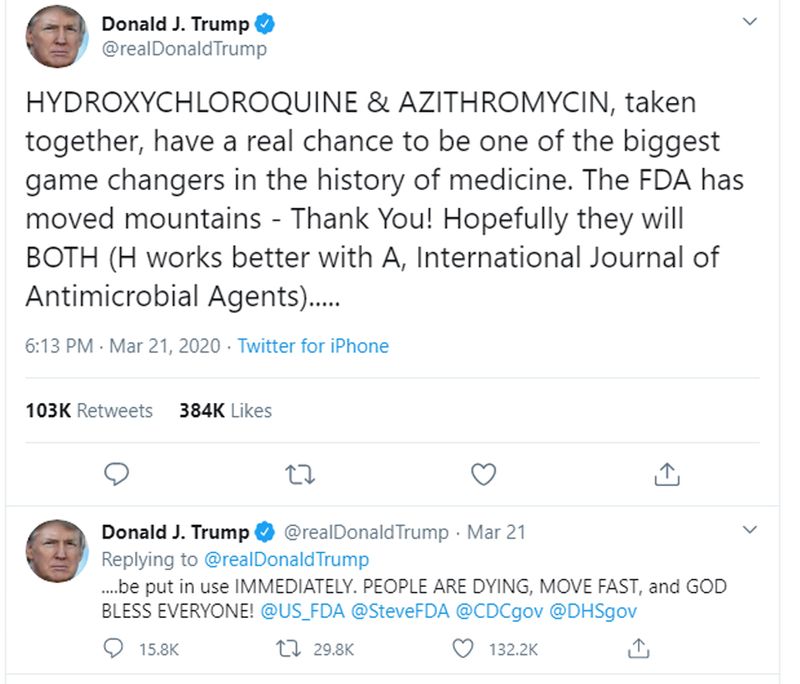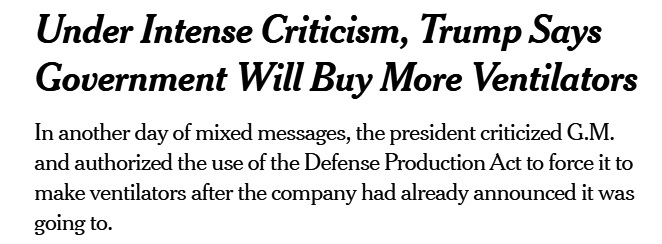March 2020 COVID 19
March 2020
March 1: the United Nations released $15 million from its Central Emergency Response Fund to the World Health Organization and UNICEF to support vulnerable countries in areas including monitoring the spread of COVID-19, investigating cases, and operating national laboratories.
March 2: the United States committed $37 million from the Emergency Reserve Fund for Contagious Infectious Diseases at the U.S. Agency for International Development for countries affected by COVID-19 or at high risk of its spread. These are the first of the funds committed from the pledge of up to $100 million announced on February 7. Countries include Afghanistan, Angola, Bangladesh, Burma, Cambodia, Ethiopia, Indonesia, Iraq, Kazakhstan, Kenya, Kyrgyzstan, Laos, Mongolia, Nepal, Nigeria, Pakistan, South Africa, Tajikistan, Thailand, the Philippines, Turkmenistan, Uzbekistan, Vietnam, Zambia, and Zimbabwe.
March 3: the World Bank Group committed $12 billion in immediate support to help countries strengthen health systems and to help cope with economic impacts of the COVID-19 outbreak.
March 2020 COVID 19
All federal limits on testing will be lifted, Pence says.
March 3: The C.D.C. lifted all federal restrictions on testing for the coronavirus, according to Vice President Mike Pence. The news came after the C.D.C.’s first attempt to produce a diagnostic test kit fell flat. By this point, the coronavirus had infected more than 90,000 around the globe and killed about 3,000, according to the W.H.O.
March 4: the Global Fund to Fight AIDS, Tuberculosis and Malaria said hat countries may use savings from their existing grants for COVID-19 response, with a limit of up to 5% of the grant’s total value. Eligible activities under this guidance included epidemic preparedness assessment, laboratory testing, transporting of samples, use of surveillance infrastructure, infection control in health facilities, and information campaigns.
March 2020 COVID 19
Trump says hoax
March 4: in an interview with Sean Hannity, Trump called the WHO’s estimate of the global death rate “false,” described the coronavirus as “very mild,” and suggested that those infected can get better by “sitting around” and “going to work.”
March 4: House passed $8.3 billion emergency bill, aimed mainly at the immediate health response to the virus.
In a Fox News interview, Trump deflected criticism to his response by saying the Obama administration (including the vice president, Joe Biden) “didn’t do anything about” swine flu. Politifact rated the claim False.
Trump continued to blame the Obama administration in an exchange with reporters at the White House.
“The Obama administration made a decision on testing that turned out to be very detrimental to what we’re doing.”
Politifact also rated that claim false also because the process dated back to 2006, before Obama took office.
March 2020 COVID 19
IMF
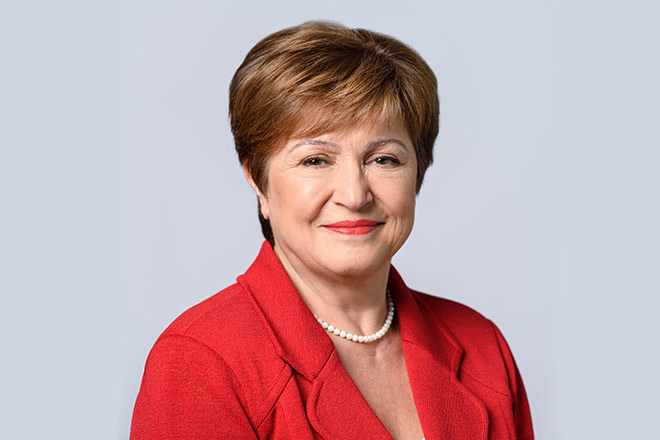
March 5: the International Monetary Fund chief, Kristalina Georgieva, says emerging market and low-income countries dealing with, or at-risk of, COVID-19 will have access to $50 billion through IMF’s rapid-disbursing emergency financing facilities. Twenty percent of this, or $10 billion, is available at 0% interest for lowest-income countries.
March 5: in a WHO briefing, Tedros praised China and the U.S. for taking “the right approach.” He said: “After our visit to Beijing and seeing China’s approach, and President Xi leading that, and also in the U.S., President Trump himself, and also for regular coordination, designating the vice president. These are the approaches we’re saying are the right ones, and these are the approaches we’re saying are going to mobilize the whole government.”
In a Fox News town hall, Trump said, “It’s going to all work out. Everybody has to be calm. It’s all going to work out.” [NPR timeline]
March 6: the U.K. announced a £46 million ($59.9 million) package for the COVID-19 response, funded by the country’s international development budget. It includes funding for the development of a vaccine and a rapid diagnostic test.
March 2020 COVID 19
Grand Princess waits
March 6: Grand Princess cruise ship with over 2,000 passengers waited to dock off the California coast.
Asked about the docking of the Grand Princess, Trump said the following:
“I would rather (Grand Princess passengers stay aboard) because I like the numbers being where they are. I don’t need to have the numbers double because of one ship.”
Trump went on to say that he thought it was more important for passengers to debark than to keep the numbers down.
March 2020 COVID 19
Not enough tests
In a news conference, Trump downplayed the concerns around testing:
“Anybody that wants a test can get a test.”
With tests in short supply, Politifact rated the claim False.
The same day, Trump tweeted out blame to the media and the Democrats for trying to “inflame” the situation “far beyond what the facts would warrant.”
The Fake News Media and their partner, the Democrat Party, is doing everything within its semi-considerable power (it used to be greater!) to inflame the CoronaVirus situation, far beyond what the facts would warrant. Surgeon General, “The risk is low to the average American.”
March 2020 COVID 19
+100,000 cases
March 7: the number of COVID-19 cases worldwide surpasses 100,000.
President Trump says, “No, I’m not concerned at all/ No, I’m not. No, we’ve done a great job.”
March 8: over 100 countries report cases of COVID-19.
March 9: WHO moves closer to declaring the COVID-19 outbreak a pandemic.
“Now that the virus has a foothold in so many countries, the threat of a pandemic has become very real,” Tedros says during a press
Trying to minimize the crisis, President Trump tweeted:
March 10: the Coalition for Epidemic Preparedness Innovations, or CEPI, invested a further $4.4 million for vaccine development efforts against COVID-19, bringing the organization’s total investments to $23.7 million. The money will be used to help Novavax and the University of Oxford in their vaccine development work.conference.
March 2020 COVID 19
Officially A Pandemic
March 11: WHO Director-General Tedros Adhanom Ghebreyesus declared the global COVID-19 outbreak a pandemic. “We are deeply concerned both by the alarming levels of spread and severity and by the alarming levels of inaction,” he says, adding that “we have called every day for countries to take urgent and aggressive action.” The decision has been made based on input from experts both internally and externally.
Trump used a prime-time Oval Office address to announce a ban on travel for non-Americans from most of Europe. He misstated a freeze on cargo and falsely said the health insurance industry has “agreed to waive all co-payments for coronavirus treatments.”
In reality, getting tested would be free, but treatment would not be covered.
March 12: the Pacific confirmed its first case of COVID-19. The patient is Maina Sage, a French Polynesian politician who recently returned from Paris.
March 2020 COVID 19
Europe Epicenter
March 13: “Europe has now become the epicenter of the pandemic, with more reported cases and deaths than the rest of the world combined, apart from China,” World Health Organization Director-General Tedros Adhanom Ghebreyesu says during a press conference. “More cases are now being reported every day than were reported in China at the height of its epidemic.”
Trump declared a national emergency to access $50 billion for states and territories, and clear the way for fast-track waivers for hospitals and doctors as they respond to the virus.
March 14: The House passed a worker and business relief bill with paid leave guarantees for certain workers, expanded food assistance and unemployment insurance benefits, and employer tax credits. Trump signedit four days later.
Namibia, Central African Republic, Republic of Congo, Equatorial Guinea, Rwanda, Seychelles, and Eswatini confirm first cases of COVID-19.
March 15: cases in Africa rose. A week earlier there were 27 cases on the continent.
Overall, there were 273 confirmed cases in 26 countries and 6 deaths. Countries respond with travel restrictions.
March 2020 COVID 19
CDC advised isolation
March 16: the C.D.C. advised no gatherings of 50 or more people in the United States over the next eight weeks. The recommendation included weddings, festivals, parades, concerts, sporting events and conferences.
President Trump advised citizens to avoid groups of more than 10. New York City’s public schools system, the nation’s largest with 1.1 million students, also announced that it would close.
March 16: for the first time since the beginning of the outbreak, infections and deaths outside China surpass those within China.
March 16: “You cannot fight a fire blindfolded. And we cannot stop this pandemic if we don’t know who is infected,” Tedros said at a briefing in Geneva. He added, “We have a simple message for all countries: test, test, test. Test every suspected case.” [NPR timeline]
March 17: Bloomberg Philanthropies announced $40 million for a COVID-19 global response initiative to prevent and slow the spread in low- and middle-income countries. This includes funding rapid response teams, training health care workers, increasing lab capacity, measuring acceptance of social distancing activities through phone surveys, providing communications support for public education campaigns, and providing expertise for health organizations. It will have a “strong focus” on African nations.
March 2020 COVID 19
Trump says stay home
March 17: President Trump said in a news conference that for the next 14 days, “we’re asking everyone to work at home, if possible, postpone unnecessary travel, and limit social gatherings to no more than 10 people.”
Trump falsely claimed that there was no shift in tone from the White House.
“I’ve always known this is a real, this is a pandemic. I’ve felt it was a pandemic long before it was called a pandemic.”
Asked if the World Health Organization had offered detection tests to the United States, Trump falsely said WHO had not, and that the WHO coronavirus test “was a bad test.”
WHO said three independent labs had validated the test, and the White House coordinator for coronavirus response said she assumed the WHO test is effective.
March 2020 COVID 19
French Lock-down
March18: France imposed a nationwide lockdown, prohibiting gatherings of any size and postponing the second round its municipal elections. The lockdown was one of Europe’s most stringent.
March 18: two Washington, D.C.-based employees of the World Bank Group tested positive for COVID-19, World Bank President David Malpass has said in a memo obtained by Devex. In the memo, Malpass says it is likely that more cases will be diagnosed among the bank’s employees in the coming days and weeks. World Bank Group staff members at the Washington headquarters were advised last week to work from home after an International Monetary Fund employee tested positive for the virus.
WHO
March 18: WHO and partners launch the Solidarity Trial, an international clinical trial that aims to generate robust data from around the world to find the most effective treatments for COVID-19.
March 2020 COVID 19
Trump false claims
March 19: cases of COVID-19 surpass 200,000 globally. It took over three months to reach the first 100,000 confirmed cases and just 12 days to reach the next 100,000.
World Food Programme Executive Director David Beasley tests positive for COVID-19 after returning to the U.S. following a visit to Canada.
The U.S. Senate unveiled a $1 trillion-plus economic stimulus package. California orders lockdown for 40 million residents.
China reported no new local infections for the previous day, a milestone in the ongoing fight against the pandemic. The news signaled that an end to China’s epidemic could be in sight.
March 20: the Asian Development Bank is making adjustments to its annual meeting this year. The bank is moving its full annual meeting to Sept. 18-21, in Incheon, South Korea. Meanwhile, its board of governors will meet on May 22 in Manila, Philippines, to consider the bank’s financial statements and net income allocation.
March 21: Ecuador’s health and labor ministers resign after cases in the country surpass 500.
East Timor, Angola, and Eritrea report first cases of COVID-19.
March 2020 COVID 19
Hospital supply shortage
The White House said that American companies were increasing efforts to restock hospitals with important supplies. Hanes and General Motors agreed to make masks and ventilators. Christian Siriano, a fashion designer, Dov Charney, the founder of Los Angeles Apparel, and Karla Colletto, a swimwear company, all agreed to repurpose their operations to create masks and hospital garments.
Gov. David Ige of Hawaii ordered a mandatory 14-day quarantine for everyone arriving in Hawaii, including tourists and returning residents.
President Trump over enthusiastically praised the possible use of hydrooxychloroquine and azithrommycin as treatments for COVID-19 even though the substance, also known as chloroquine phosphate, had not gone through rigorous scientific testing as a coronavirus treatment.
March 2020 COVID 19
300,000+ cases
March 22: global cases of COVID-19 surpass 300,000. It took over three months to reach the first 100,000 confirmed cases, 12 days to reach 200,000 and three days to reach 300,000.
March 23: World Bank Group President David Malpass called on bilateral creditors of the lowest-income countries to provide debt relief so these countries can focus resources on the COVID-19 pandemic, during a G-20 finance ministers conference call. He also calls on countries to implement structural reforms including removing “obstacles” such as “excessive regulations, subsidies, licensing regimes, trade protection or litigiousness.”
March 23: in a WHO briefing, Tedros said, “Using untested medicines without the right evidence could raise false hope and even do more harm than good.”
He also said that the “pandemic is accelerating. … It took 67 days from the first reported case to reach the first 100,000 cases, 11 days for the second 100,000 cases and just four days for the third 100,000 cases.” [NPR timeline]
March 2020 COVID 19
UK closes
United Kingdom Prime Minister Boris Johnson closed all nonessential shops, barred meetings of more than two people, and required all people to stay in their homes except for trips for food or medicine. Those who disobey risked being fined by the police.
Following the “advice” of President Trump, a Phoenix-area man died after ingesting chloroquine phosphate, thinking it would protect against the coronavirus.
March 24: India’s Prime Minister Narendra Modi announced a lockdown of 21 days for the country’s 1.3 billion residents. This is the largest lockdown announced since the beginning of the outbreak.
March 2020 COVID 19
Olympics postponed
March 24: Officials announced that the Summer Olympics in Tokyo would be postponed for one year.
One day after the authorities halted all domestic flights, Narendra Modi, India’s prime minister, declared a 21-day lockdown. While the number of reported cases in India was about 500, the prime minister pledged to spend about $2 billion on medical supplies, isolation rooms, ventilators and training for medical professionals.
March 25: reached after midnight, the White House and Congress agreed in principle to deliver $2 trillion in government relief to a nation increasingly under lockdown, watching nervously as the twin threats of disease and economic ruin grow more dire.
The rescue deal was the product of a marathon set of negotiations among Senate Republicans, Democrats and the White House that had stalled as Democrats insisted on stronger worker protections and oversight of a $500 billion fund to bail out distressed businesses.
The Senate voted unanimously on the same day to approve the sweeping measure, advancing the largest fiscal stimulus package in modern American history.
The House was expected to quickly take up the bill.
March 2020 COVID 19
More false hopes
March 24: President Trump said on Fox News he wanted the U.S. economy to “open” back up by Easter Sunday, even as the number of coronavirus cases in the country accelerates.
In another Fox interview, Trump said, “You’ll have packed churches all over our country … I think it’ll be a beautiful time.”
March 26: more than three million people filed for unemployment benefits in the United States last week.
In the half-century that the government had tracked applications, the worst week ever was in October 1982 with 695,000 “initial” claims.
The latest numbers, released by the Labor Department were some of the first hard data on the economic toll of the coronavirus pandemic, which had shut down whole swaths of American life faster than government statistics can keep track.
Just three weeks ago, barely 200,000 people applied for jobless benefits, a historically low number.
March 26: “We are at war with a virus that threatens to tear us apart,” said Tedros to world leaders in a special virtual summit on the COVID-19 pandemic. [NPR timeline]
March 2020 COVID 19
US Record
 March 26: the NYT reported that scientists had warned that the United States someday would become the country hardest hit by the coronavirus pandemic. On this date, that moment arrived.
March 26: the NYT reported that scientists had warned that the United States someday would become the country hardest hit by the coronavirus pandemic. On this date, that moment arrived.
At least 81,321 people were known to have been infected with the coronavirus, including more than 1,000 deaths — more cases than China, Italy or any other country had seen.
March 27: NPR reported that when asked why the United States did not import coronavirus tests when the Centers for Disease Control and Prevention ran into difficulty developing its own, Trump government officials had questioned the quality of the foreign-made alternatives referring to a Chinese study that reported nearly half false-positives.
NPR learned that that study was retracted just days after it was published online in early March.
March 2020 COVID 19
U.S. cases surpass 100,000 as Trump signs $2 trillion aid package into law.
March 27: President Trump signed into law a $2 trillion measure designed to respond to the coronavirus pandemic. In the largest economic stimulus package in modern American history, the government will deliver direct payments and jobless benefits for individuals, money for states and a huge bailout fund for businesses battered by the crisis.
The NY Times reported that President Trump had announced that the federal government would buy thousands of ventilators from a variety of makers.
His announcement came shortly after authorizing the government to “use any and all authority available under the Defense Production Act,” a Korean War-era authority allowing the federal government to commandeer General Motors’ factories and supply chains, to produce ventilators.
Just 24 hours before, Trump had dismissed the complaints of mayors and governors who said that they were getting little of the equipment they needed for an expected onslaught of serious cases.
March 2020 COVID 19
More Than 2,000 Americans Have Now Died From The Coronavirus
March 28: NPR reported that the United States had marked another grim milestone in its fight against the coronavirus, when the number of deaths from the virus topped 2,000.
According to data from Johns Hopkins University, 2,010 Americans had died from the coronavirus. The majority of deaths had been in New York City.
The United States reported its first death from the coronavirus on February 29. On March 26, the count reached 1,000 deaths. From there, it took just two days for the count to hit the 2,000 mark.
In all, there are now more than 121,000 confirmed coronavirus cases in the country, more than any other nation.
March 2020 COVID 19
Quarantine/No Quarantine
C.D.C. issues a travel advisory for the New York region, after Trump backs off his quarantine threat.
March 28: the NY Times reported that President Trump had said on that he would not impose a quarantine on New York, New Jersey and Connecticut but would instead issue a “strong” travel advisory to be implemented by the governors of the three states.
Mr. Trump made the announcement on Twitter just hours after telling reporters that he was considering a quarantine of the three states in an effort to limit the spread of the coronavirus to Florida and other states.
Later that same night, the C.D.C. issued a formal advisory urging the residents of the three states to “refrain from nonessential domestic travel for 14 days effective immediately.”
Trump extended the federal government’s social-distancing guidelines through the end of April.
March 29: the NY Times reported that President Trump said that the federal government’s guidelines for social distancing would last until April 30, backing down from his previous comments that he hoped the country could go back to work by Easter.
He had clashed with public health experts around the country when he suggested on March 24 that the guidelines — which urge people to stay at home and not to gather in groups of more than 10 — might be relaxed by April 12. His announcement indicated that he had backed down from that suggestion.
President Trump, citing no specific data, says he expects new infections to peak by Easter
March 30: the NY Times reported that President Trump said that he and his advisers expected the number of people who tested positive for the coronavirus to peak around Easter, though he cited no data to back up his claim.
”That’s going to be the highest point, we think, and then it’s going to start coming down from there,” Mr. Trump said during an interview on Fox & Friends. “That will be a day of celebration, and we just want to do it right so we picked the end of April.”
At this point, the United States led the world in the number of confirmed coronavirus cases.
March 2020 COVID 19
President Trump, citing no specific data, says he expects new infections to peak by Easter
March 30: the NY Times reported that President Trump said that he and his advisers expected the number of people who tested positive for the coronavirus to peak around Easter, though he cited no data to back up his claim.
”That’s going to be the highest point, we think, and then it’s going to start coming down from there,” Mr. Trump said during an interview on Fox & Friends. “That will be a day of celebration, and we just want to do it right so we picked the end of April.”
At this point, the United States led the world in the number of confirmed coronavirus cases.
No shortage/severe shortage
March 30: the NY Times reported that President Trump had told governors on a conference call: “I haven’t heard about testing in weeks. We’ve tested more now than any nation in the world. We’ve got these great tests and we’re coming out with a faster one this week.”
Trump added, “I haven’t heard about testing being a problem.” suggesting that a chronic lack of kits to screen people for the coronavirus was no longer a problem.
But governors painted a different picture on the ground.
Gov. Steve Bullock of Montana, a Democrat, said that officials in his state were trying to do “contact tracing” — tracking down people who have come into contact with those who have tested positive — but that they were struggling because “we don’t have adequate tests,” according to an audio recording of the conversation obtained by The New York Times.
“Literally we are one day away, if we don’t get test kits from the C.D.C., that we wouldn’t be able to do testing in Montana,” Mr. Bullock said.
March 2020 COVID 19
- COVID 19 Pandemic Begins
- February 2020 COVID 19
- April 2020 COVID 19
- May 2020 COVID 19
- Trump/COVID 19 Begin
- Trump COVID 19 Continue
- April 2020 Trump COVID
- June 2020 COVID 19
- July 2020 COVID 19
- August 2020 COVID 19
- September 2020 COVID 19
- October 2020 COVID 19
- November 2020 COVID 19
- December 2020 COVID 19
- Winter 2021 COVID 19
- Spring 2021 COVID 19
- Summer 2021 COVID 19
- Fall Winter 2021 COVID
